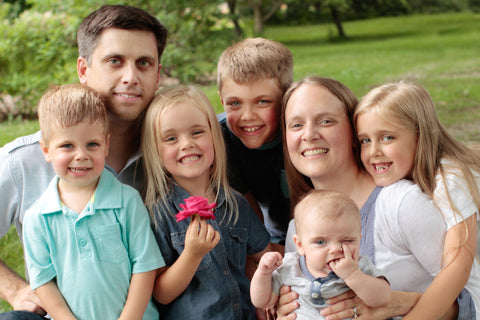For our first blog post we're featuring an interview with founder, Sy Belohlavek. Have more questions for Sy? Leave us a comment or ask on social media!
When did you first go to Kyrgyzstan?
I grew up living overseas a lot, since my parents are in development work. As a college student, I was required to spend time abroad, and I wanted to go to the most unknown and intriguing place, and for me that was Kyrgyzstan. I first went in 2001 on a cross cultural trip as a student, and I fell in love. I went back in 2003 to volunteer at a university for a year.

Belohlavek family
How did you get into the cashmere yarn business?
I was back in my hometown of Columbus, OH and I was between jobs. Through some friends I was introduced to JC Christensen, the owner of Morning Star Fibers. JC had met some Kyrgyz artists who showed up at the door of the mill while in Ohio for a cultural exchange, and they had planted the seed in JC of setting up a mini-mill in Kyrgyzstan to process the high quality cashmere available there. When I originally moved to Kyrgyzstan in 2010, it was to do some on-the-ground setup, and JC was planning on moving to Kyrgyzstan with his family to set up the mill. It didn’t work out for Morning Star Fibers and JC’s family to come to Kyrgyzstan, but I saw the immense potential and decided to move forward with the project myself. That was the beginning of June Cashmere.
Do you knit?
Not yet! But my daughters are learning to knit. Maybe they will teach me?
Can you tell us more about how you collect cashmere in Kyrgyzstan?
In rural Kyrgyzstan, families live off the land. The value of the goats is in the meat, and goats are the fastest and least expensive to raise to maturity. Most families have a mix of goats and sheep, and more wealthy families also have cows and yak. Because goats are the cheapest, the families with less means tend to own more goats.
In the past, Chinese traders would come to Kyrgyzstan and buy cashmere by the kilo, paying a flat rate. This created an economy for cashmere that didn’t value quality, and encouraged families to shear their animals, which resulted in a mix of hair and fiber, instead of combing for cleaner, higher quality fiber.
It’s taken a lot of time and outreach, but we’ve been changing the culture of cashmere through a direct economic reward. In the Spring when we collect cashmere, we have a tiered pricing system: at first it was based on cleanliness, i.e. how much hair vs. cashmere, but now we’re able to base it on the fineness of the fiber due to the increase in quality cashmere in just a few short years.

Can you tell us more about the difference between hair and cashmere?
Most of the hair on a cashmere goat is guard hair. The downy undercoat is the cashmere, which grows around the actual hair follicle. In the spring, the goats molt the fine downy undercoat, and this is when cashmere is harvested from the animals. Whether the fiber is combed or sheared, it still has to be de-haired for the coarse guard hairs, but combed cashmere results in much more clean, useable fiber than sheared fiber.

Each bag of combed cashmere is inspected at the point of sale; it is then weighed and the shepherd is paid directly
This sounds like an immense amount of work, teaching Kyrgyz communities about how to comb, and how to evaluate the quality of their cashmere. How do you manage all of this while still creating contacts in Europe for a mill, managing the retail side, and running a business in two countries?
I get a lot of help. On the ground I work with an amazing coordinator, Kanat, (pronounced KUH-nat), who spends time talking to people and teaching them about what type of cashmere has the most value and how to best harvest the fiber.
From the beginning I knew I couldn’t do this all myself, so I’ve been thoughtful in seeking experts in the hand knitting industry, such as a distributor to help with wholesale orders of the yarn and a warehouse in Ohio that ships the yarn out to consumers.
Want to learn more about June Cashmere, and see more photos of Kyrgyzstan? See our digital lookbook for more about the story of this beautiful fiber.

